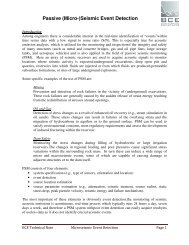SC3-RAV™ 2011 - Baziw Consulting Engineers Ltd.
SC3-RAV™ 2011 - Baziw Consulting Engineers Ltd.
SC3-RAV™ 2011 - Baziw Consulting Engineers Ltd.
Create successful ePaper yourself
Turn your PDF publications into a flip-book with our unique Google optimized e-Paper software.
BCE <strong>SC3</strong>RAV <strong>2011</strong> Seismic Data Analysis Software<br />
3.1.3 Forward Modeling Downhill Simplex Method<br />
The FMDSM technique utilizes seismic ray tracing and optimal estimation techniques in deriving<br />
DST interval velocities. The standard techniques implemented in deriving DST interval velocities<br />
rely upon obtaining reference P and S wave arrival times as the probe is advanced into the soil<br />
profile. By assuming a straight ray travel path from source to seismic receiver and calculating<br />
relative reference arrival time differences, interval DST velocities are obtained.<br />
The Forward Modeling / Downhill Simplex Method offers distinct advantages over conventional<br />
DST velocity profile estimation methods, such as:<br />
• Utilization of Snell’s Law at layer boundaries for ray path refraction.<br />
• Optimization of a non-linear cost function, which takes into account more details of the<br />
DST testing environment and the recorded seismic data.<br />
• Allowance for measurement weights to be specified, the possibility to incorporate<br />
unlimited input data (e.g., crossover point arrival times, maximum cross-correlation time<br />
shifts, angles of incidence and P-wave / S-wave time separations) into the interval<br />
velocity estimation algorithm.<br />
• Ability to accurately interpolate interval velocities when measurement data are not<br />
available.<br />
• Reporting of meaningful error residuals, which indicate the accuracy of the estimated<br />
interval velocity.<br />
Please refer to Appendix 2 for<br />
further details and the ability of<br />
the FMSDM to obtain variable<br />
interval velocity estimates. In<br />
the FMDSM the user is<br />
provided with user friendly<br />
interfaces for specifying<br />
seismic wave arrival times with<br />
corresponding weights within a<br />
Windows ® compatible database.<br />
This information is derived<br />
from implementing SC1-<br />
RAV menu<br />
options<br />
Crosscorrelation Technique-<br />
>Batch Job Analysis with<br />
Display and Calculate Arrival<br />
Times option enabled. The<br />
graphical screen illustrated in<br />
Figure 23 appears when the<br />
FMDSM menu option is<br />
selected.<br />
Figure 23: Main graphical interface screen in the<br />
FMDSM software option showing the Source Offset<br />
Parameters input tab<br />
Version 11.1.0 Page 15




